Matador Network's Blog, page 483
May 4, 2022
These 7 Small Cities Are the Perfect Basecamp for Outdoor Adventures
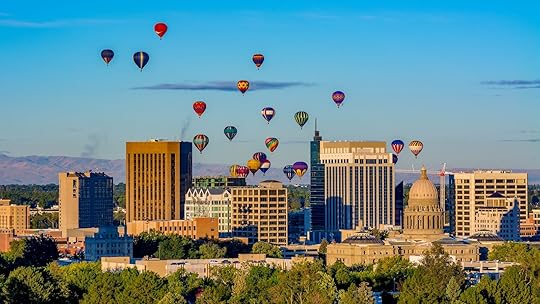
SOME GETAWAYS are mainly focused on enjoying awesome outdoor adventures like hiking, kayaking, and mountaineering. Others are focused on enjoying the luxury of a soft and warm bed, sitting at a trendy cocktail bar, or diving into tasty food at a top-tier restaurant. Those who want the best of both worlds can check out these seven smaller cities to build an itinerary that features a balance of both outdoor experiences and ample urban metropolitan excitement.
We hope you love the outdoorsy small cities we recommend! Just so you know, Matador may collect a small commission from the links on this page if you decide to book a stay. Listed prices are accurate as of the time of publication.
Reno, Nevada
Photo: Andrew Zarivny/Shutterstock
Reno, Nevada is a fantastic home base for embarking on daytime adventures in nearby destinations like North Tahoe and Incline Village. After a day of hiking or mountain biking, grab a bite at Liberty Food & Wine Exchange. This artisan eatery, market, and wine bar showcases hand-crafted and hearty shareable plates. Or, grab a brew at The Depot, which is a craft brewery and distillery located inside an old railroad station. And nearby, The Eddy is an outdoor container bar sitting along the Truckee River offering local brews, cocktails, and games, plus food trucks stocked with tasty bites.
Where to stay
Spend the night at Whitney Peak Hotel which is located in the heart of downtown right by the Reno Arch. This hotel has stunning views of the city and the Sierra Nevada mountains and is also home to Basecamp Climbing Gym, which includes an indoor bouldering park and an outdoor climbing wall running up the side of the hotel and is open to guests.
Build your itinerary
How Reno reinvented itself without losing its edgeLight up the night: Making the most of Reno Tahoe’s dark skies5 winter adventures in and around Reno, NevadaGrand Junction, Colorado
Photo: Jeremy Janus/Shutterstock
Escape the crowds of Denver and Boulder and instead head to Grand Junction, Colorado, for the ultimate mountain outdoor adventure experience. It’s an outdoor enthusiast’s paradise, surrounded by more than one million acres of public lands with access to rivers, canyons, mesas, and mountains. Check out the Rattlesnake Canyon Arches or embark on an ATV tour of the Colorado National Monument. After a day of exploring, sample local wines at Carlson Vineyard’s new downtown Grand Junction tasting room, or stop by Highlands Distillery which produces great handcrafted spirits utilizing local ingredients to create regionally-inspired cocktails. And the new Foam & Folly Brewery & Taproom serves up great beer in a whimsical space with a great backyard beer garden.
Where to stay
Spend the night at Hotel Maverick, which offers complimentary cruiser bikes for guests, a pump park, and disc golf, and boasts an enormous property for wandering. If wine touring is part of the plan, consider staying in nearby Palisade – home more than two dozen wineries – at the Wine Country Inn, which offers daily tastings and has an extensive wine list in its onsite restaurant, Caroline’s.
Build your itinerary
How to bike the Fruit & Wine Byway in Palisade, ColoradoColorado’s new Palisade Plunge is the ultimate mountain bike mega-trail11 insanely cool river-rafting trips in Colorado you need to takeBeyond the resorts, Colorado’s lesser-known mountain towns are the next big destinationsBoise, Idaho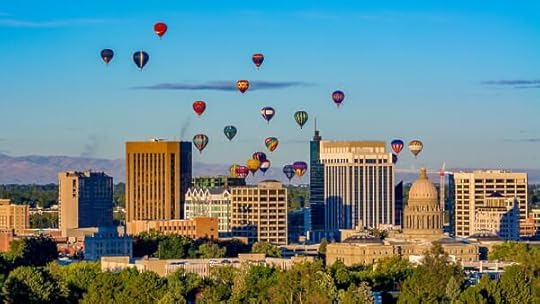
Photo: Charles Knowles/Shutterstock
There are seemingly endless opportunities for outdoor exploration when using Boise as home base. Try sandboarding or climbing the sand dunes at Bruneau Dunes State Park, ziplining at Tamarack Resort, or go whitewater rafting on the Main Payette River in Banks. After working up an appetite, head back to the city for a bite and check out one of the three James Beard Award nominees: Sunshine Spice Café by Chef Khatera Shams, Ansots by Chef Dan Ansotegui, and KIN by Chef Kris Komori. Craft Cocktail lovers should stop into The Modern, Press & Pony, or The Mode Lounge. Beer lovers can enjoy a craft brew at local favorite, Barbarian Brewing.
Where to stay
Those who seek to spend the night in a centrally located spot in downtown Boise should visit the luxurious Grove Hotel which offers breathtaking views of the Boise foothills in the distance.
Build your itinerary
10 underground things to do in Boise before they go mainstreamRaft Idaho’s Salmon River and actually help the salmon in their fight to surviveBest of the Idaho outdoorsWhy anyone who loves waterfalls needs to plan a trip to southern IdahoFlagstaff, Arizona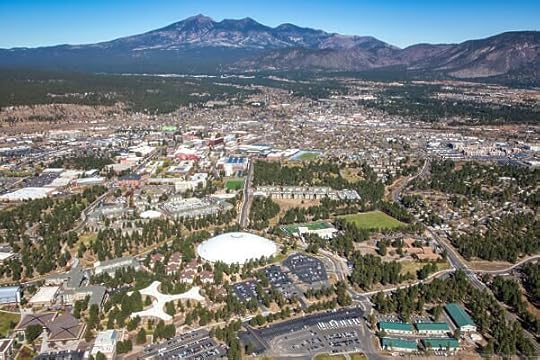
Photo: Tim Roberts Photography/Shutterstock
Flagstaff, Arizona, is full of adventure. Fuel up at Macy’s European Coffee House and Bakery, one of the town’s few all-vegetarian restaurants. Nearby Diablo Burger serves bites that are made from 100 percent local, open range-raised, antibiotic-free, and growth-hormone-free beef. For drinks, Flagstaff’s Brewery Trail offers something for everyone’s craft beer palate. Look to the skies and ponder the cosmos at the Lowell Observatory, which features one of the finest collections of telescopes available for public observation by both night and day. And Snowbowl makes for great skiing in the winter ,and in the warmer months you can enjoy a scenic gondola ride up the mountain.
Where to stay
Spend the night at Little America Flagstaff, which offers an outdoor pool and hot tub, restaurant and bar, a kids’ playground, and easy access to nature trails. Matador named Little America as the best roadside motel brand in the United States.
Build your itinerary
Forget Houston. Flagstaff is actually the lunar capital of America.How to visit the Grand Canyon in one dayThe ultimate Arizona road tripBurlington, Vermont
Credit: Hello Burlington
Start the day with a trip to the Outdoor Gear Exchange, a great spot to grab gear for any type of excursion, including biking, skiing, snowboarding, ice climbing, rock climbing, SUPping, kayaking, and more. Those who prefer to explore the town can walk down Church Street, which is a pedestrian-friendly area in the heart of the city featuring a string of locally-owned shops and restaurants just blocks from the waterfront. And be sure to walk along Pine Street, also known as “Brewery Boulevard,” which runs from Church Street down through the city’s South End. This street is home to classics like Zero Gravity, Burlington Beer Company, Switchback, Citizen Cider, Queen City Brewery, and many more. Pine Street has also become the heart of the city’s natural wine scene, with Dedalus Wine and Wilder Wines vending the best wines made from organically farmed grapes.
Where to stay
Spend the night at Hotel Vermont in the heart of downtown which offers easy access to the Burlington Waterfront and the buzzy culinary hotspot Hen of the Wood, which provides a true Vermont dining experience of the region’s most vibrant foods.
Build your itinerary
4 seasons of Vermont: A year-round travel guide to the Green Mountain StateVermont adventure guide: Hiking, biking, paddling, and moreThe 9 best state parks in VermontSanta Rosa, California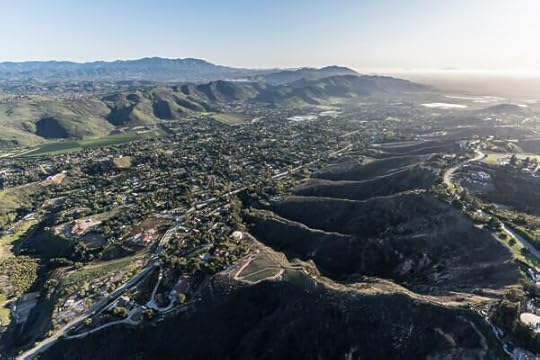
Photo: trekandshoot /Shutterstock
Santa Rosa feels like the best of all worlds when it comes to its robust food, drink, and adventure scene. First, plan a tour with Safari West, where herds of wildebeest, romping rhinos, and towering giraffes roam the lands on a 400-acre preserve and practically transport tour-goers into the Serengeti. Step back in time with a visit to Historic Railroad Square which offers a collection of trendy shops, coffee houses, and restaurants. Visit Trione-Annadel State Park which has miles upon miles of trails for hiking, mountain biking, and trail riding through the 5,500-plus acres of rolling hills, seasonal streams, meadows, and woodlands. Refuel at Perch + Plow which serves small plates and craft cocktails that taste as good as they look.
Where to stay
After an eventful day, spend the night at Hotel E, a new, centrally located luxury boutique hotel perfectly perched in the iconic beaux-arts building in downtown Santa Rosa’s Old Courthouse Square.
Build your itinerary
How Sonoma became America’s most sustainable wine regionWhat it’s like to go forest bathing in Sonoma County, CaliforniaThis sustainable Sonoma wine brand is packaged for outdoor adventureAlbuquerque, New Mexico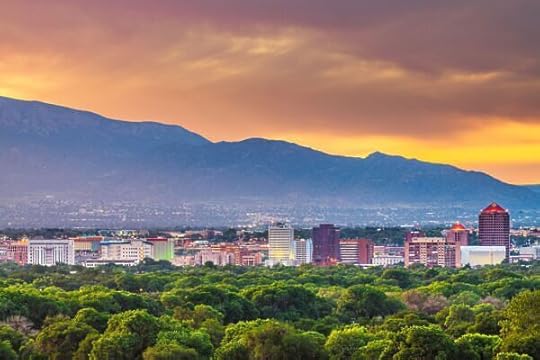
Photo: John Doe/Shutterstock
In Albuquerque, New Mexico, the recent additions of Sawmill Market and 505 Central Food Hall make it an awesome place for fueling up before (or after) a day of awesome outdoor experiences. There are practically endless cycling trails to explore with Routes Bicycle Tours & Rentals, which just added the tasty new ABQ Bike & Taco Tour. Visit Plaza Don Luis in Old Town to enjoy two new wine-tasting rooms — Ruidoso-based Noisy Water Winery and Albuquerque-based Sheehan Winery — or the Outpost Brewery and Taproom. And what would a trip to Albuquerque be without an iconic hot air balloon ride? Rainbow Ryders hosts a diverse lineup of ride types from group to private excursions at sunrise and sunset, showcasing views of the city from an unparalleled bird’s eye view.
Where to stay
Settle down and spend a night at Hotel Chaco, which is practically an art gallery and museum in addition to a luxury boutique hotel.
Build your itinerary
How outdoor recreation is saving the economy of a former oil town in New MexicoWhy Abuquerque is the perfect fall getawayAlbuquerque’s annual balloon festival is back, and it’s going to be epicWhat to do in Albuquerque beyond ‘Breaking Bad’ tours

This Kenyan Gin Bar Is the Best Place To See Elephants on Safari

The elephant sightings began as soon as my charter flight touched down on the dirt airstrip in Kenya‘s Maasai Mara National Reserve. My guide and I hopped into a safari Jeep and followed them, big lumbering gray masses that looked at once extremely friendly and incredibly dangerous. This wasn’t an elephant in a zoo; I was on their territory now, surrounded by tall grasses waving in the light breeze and the midday sun. A baby elephant — no more than three months old, my guide told me — trotted alongside its family, stopping to look at us for a moment before running to catch up.
The future of that particular baby elephant is tenuous. Life as a child in the Kenyan wilderness comes with a lot of risks. The elephant could end up orphaned because a lion killed its mother, the mother elephant died from natural causes, or even from something as simple as the baby wandering off and getting left behind accidentally. But there is a surprising way that humans are helping elephants survive – all while indulging the comforts of a luxury safari.

Photo: Jennifer Billock
That’s where luxury safari lodging &Beyond Bateleur Camp and its carefully curated gin bar come in. The camp sits in a private corner of the Mara at the tail end of the wildebeest migration trail. It has 20 high-end tents with copper bathtubs, plush beds, and entire walls of screen so you can commune with nature at night while keeping the bugs out.
And in the center of the camp is the gin bar, which is in a tent of its own with pendant lighting and cozy sofa seating. The bar stocks 16 different gins and specializes in gin and tonics made with organic herbs and ingredients grown in the camp’s on-site shamba, an organic vegetable garden. But one variety of gin is especially important: The Elephant Gin. For every bottle of elephant gin sold at Bateleur Camp, 15 percent of the profits go to help orphaned elephants at The David Sheldrick Wildlife Trust in Kenya and the Big Life Foundation in East Africa.
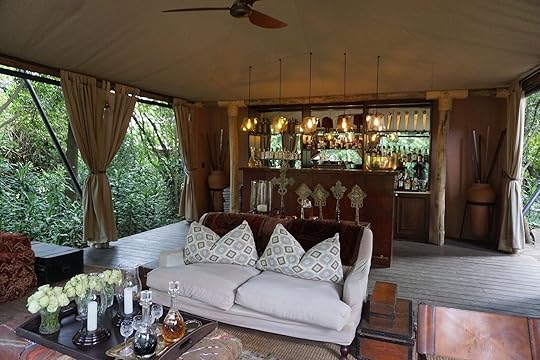
Photo: Jennifer Billock
“We specialize in gin because it’s very medicinal,” says Esther Baridi, one of the camp managers. “In Africa we have a history of malaria. When you drink gin, it’s like you’ve taken a shot of medicine. The gins all have herbs that have healing effects in the body. When you have a gin and tonic, you’re already healed. You’re helping your body and helping yourself.”

Photo: Jennifer Billock
Elephant Gin is a London dry gin made with 14 organic botanicals, including cassia bark, juniper, elderflower, and pimento berries. It smells and tastes citrusy, with a hint of lemon on the tail end of a sip. The program currently supports 22 orphaned elephants, each of which have a batch of the gin named after them and their name hand-written in calligraphy on the bottles. The donations are used to provide milk and care for each orphaned elephant. When the elephants are old enough to survive on their own, they’re released back into the wild
“The program keeps the elephants growing for the next generation,” Baridi says. “We’re looking after our animals so they don’t go extinct.”
Employees at Bateleur Camp see firsthand the benefits of the program. Baridi told me of a baby elephant that was orphaned near the airstrip. The Sheldrick Wildlife Trust came and airlifted the elephant out of the Mara, removing all the seats inside a plane so it could sit inside for the flight. Baridi watched the evacuation.
“It was only about a month or two old,” she says. “It was a very powerful moment.”
The orphaned elephant was taken to Nairobi, where the Sheldrick is based. There, it was raised and fed by hand — along with help from a line of visitors who can sign up in advance to bottle-feed the elephants. Sometimes guests at Bateleur Camp return from the Sheldrick with news of how the rescued elephants are doing. And sometimes the camp sees it personally, like when they witnessed the reunion of an elephant who had been raised at the Sheldrick with its caretaker. The elephant saw him, recognized him, and immediately ran over to say hello.
Raising the elephants takes a lot of work, but it’s at the core of &Beyond’s mission as a company, to support not just local people and the environment, but also the animals living nearby.
“When we sell Elephant Gin, it means every guest that drinks is contributing,” Baridi says.
I had to do my part, of course, so I enjoyed a gin and tonic made with Elephant Gin from the Hipolito batch and fresh mint and sliced apple from the garden. I’d been struggling that day, coughing from dust on the roads we were driving on as we followed the elephants, lions, and giraffes through the Mara. It was heartwarming to contribute to the elephant cause. The gin and tonic helped me back — as soon as I finished it, my cough was gone. 
Guide to NMAAM in Nashville, TN
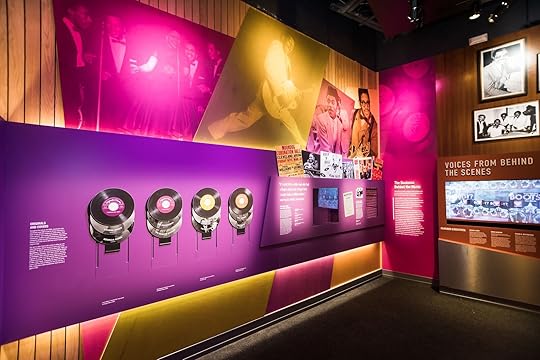
Nashville, Tennessee, is full of museums dedicated to musical artists and genres — the Country Music Hall of Fame and Museum, the Musicians Hall of Fame and Museum, and the Johnny Cash Museum, are the most famous among them. But Music City could do with one more music-centric cultural institution so, in January 2021, the National Museum of African American Music (NMAAM) opened its doors in Downtown Nashville.
According to Byron Harvey, Guest Services Supervisor at the National Museum of African American Music, “The museum celebrates African American music and its contributions to the American soundtrack.”
Visiting the National Museum of African American Music is like taking a trip through a musical time machine. To make sure you make the most of your visit to this museum, follow our comprehensive guide.
The #1 piece of advice before visiting the museumHours of operationTicket pricesParkingWhere to start your visitHow long should I plan to visit the museumVisitors’ wristbandsActivities you should not skipFive must-see galleriesThe #1 piece of advice before visiting the National Museum of African American Music
Photo: the National Museum of African American Music
It is best to purchase your tickets online in advance. That said, arrive about 15 minutes before your scheduled time to get your wristband (more on this later on) and enjoy some of the live music in the lobby. Also, self-directed tours of the museum start every half hour and if you arrive late or you’ll have to wait for the next group.
Note that the museum uses timed tickets to manage capacity and ensure each visitor has an opportunity to get the full experience without overcrowding.
National Museum of African American Music hours of operationNMAAM is open from 9:00 AM to 5:00 PM Wednesday to Monday. The gift shop is open seven days a week from 10 AM to 5 PM.
National Museum of African American Music ticket pricesAdult (18 and older): $24.95Youth (Age 7-17): $13.50Youth (Age 6 and under): FreeSenior (Age 65 and older): $18.75Student/Teacher/Military (ID required): $18.75Parking at the National Museum of African American MusicThere is public parking conveniently available in the garage on Sixth Street and Broadway Street which is located directly behind the museum. If you are driving, it is recommended that you arrive 30 minutes before your scheduled time to give yourself time to park and make your way to the museum.
Address: 510 Broadway, Nashville, Tennessee 37203
Where to start your visit to the National Museum of African American MusicNMAAM is appropriately located on Broadway Street, Nashville’s entertainment center, where a multitude of honky tonks play live music every night.
You will access NMAAM via the Fifth Street and Broadway entrance (also known as Fifth and B by the locals), but before walking in, we encourage museumgoers to take in the sights and sounds of one of the most famous streets in the United States. It is a fitting introduction to what you will experience inside the museum.
Start you visit with the lobby where you can listen to live music in amphitheater-style seating. Take the time to admire the decor of the space, including the wall of instruments, and the light fixtures built to look like drumsticks.
From the lobby, you are also able to visit the beautifully decorated Amplify gift shop. There are records on the walls, record covers on the ceiling, a car cut in half with its trunk open that serves as a display shelf, and more fun decorations. Amplify sells vinyl records, record players, and books, along with clothing and traditional gift shop items.
How long should I plan to visit the National Museum of African American Music?
Photo: the National Museum of African American Music
The estimated tour time is 90 minutes, but guests are encouraged to take as much time as they need.
The visit starts inside of the Roots Theater where guests watch a short film on the history of African music and its global influence. Once the film is over, attendees are directed to exit to the right to begin their self-directed tour.
The museum’s exhibits are organized in chronological order starting with the first enslaved Africans being brought to America. Visitor can take in the museum at their own pace through galleries focusing on gospel, blues, jazz, rhythm and blues and lastly hip-hop.
Visitors’ wristbands at the National Museum of African American MusicUpon presenting yourself at the reception desk of the museum, you will be given a wristband. This wristband is linked to the email address that you provided when you purchased your ticket, which will also be confirmed before your tour starts.
The museum staff will instruct you on how to use your wristband if you need help, but it’s straightforward. Your wristband can be used throughout the museum’s exhibits to save part of your museum experience. Just wave the wristband in front of the sensor on the display to save an artist’s playlist or your own prowess as a dancer or singer. Whatever is saved to the wristband, will be available for 60 days after the date of the museum visit.
Activities you shouldn’t skip at the National Museum of African American Music1. One Nation Under a Groove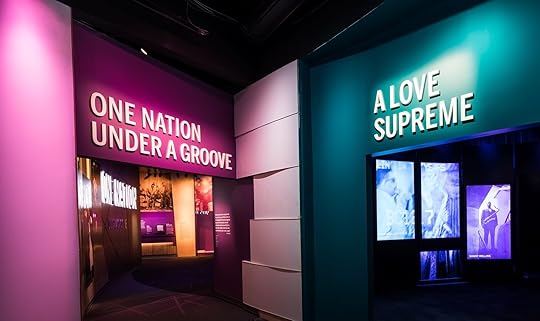
Photo: the National Museum of African American Music
Along with the evolution of music comes the transformation of dancing. In the One Nation Under a Groove gallery you have the opportunity to show off your dance skills to mix education and fun. Alone or with a group, you can go into the large room that resembles a dance studio and give it your all. A silhouette on the large screen in the front of the room will show you the steps. The first song will be from the 1950s, and each song that follows will be from the next decade. The last song to play is “Love On Top” by Beyonce (2010s), and during that tune, your own dancing silhouette will be recorded. You’ll then have the option to save your dance video on your wristband.
2. To be an MCEnter the booth, settle under the mood lighting, and record yourself rapping along to a song, karaoke-style. You can go in solo or with a group — either way, you’ll have fun and gain a new appreciation for what hip-hop artists do. You can save your rapping session thanks to your wristband.
3. The Roots & Streams interactive kiosksOne of the coolest activities at the museum is creating a custom music playlist. The Roots & Streams interactive kiosks, found throughout the museum, are fitted with noise-canceling headphones that allow for the opportunity to listen to the music without interruption. The kiosks will have you learn about new artists or rediscover others. You can save the music you enjoyed thanks to your wristband to listen to it again after your visit.
Five must-see galleries at the National Museum of African American MusicWade in The Water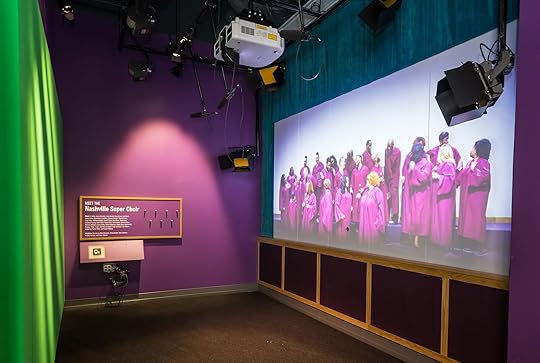
Photo: the National Museum of African American Music
The Wade in The Water gallery is all about gospel, and gospel is the foundation of all the other music genres, and museum exhibits, to come. During slavery, the one place where the enslaved were allowed to gather was church. Enslaved people did not have much hope but religion and their music was critical in their survival. The church was the one place that enslaved and, subsequently, free people of color felt safe. A quote on the museum wall from the great American Gospel singer Mahalia Jackson says, “I sing God’s music because it makes me feel free. It gives me hope.” The gallery has church pews on which you can sit and listen to early gospel music.
Crossroads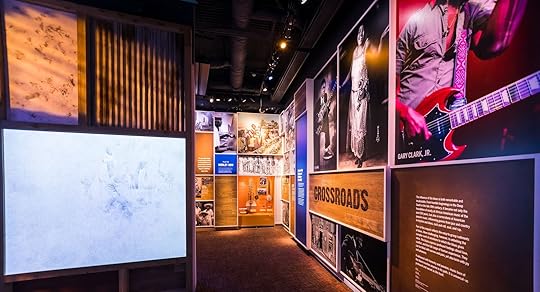
Photo: the National Museum of African American Music
New music began to emerge at the end of the Civil War. The Jim Crow era in the South brought difficult times to the majority of Black people living there. During this time, Black music focused more on personal hopes and needs instead of the collective, as they did during slavery. This is when the blues genre of music was formed. The artifacts on display in the Crossroads gallery are from the late 1800s and post-slavery. They represent the instruments musicians would have played during this time period, such as a 18th-century one-string fiddle made with a gourd body and lizard skin.
Before moving on to the next gallery, try your hands at the diddley bow, another single-stringed instrument. According to the museum, many blues musicians played the diddley bow as their first instrument during this period.
A Love SupremeThe Love Supreme gallery retraces the story of jazz. The musical genre began in the mid-1700s in New Orleans. There, the enslaved were allowed to gather on Sundays and other holy days to play music, dance, as well as trade and sell goods on Congo Square (located within Louis Armstrong Park.) It is on Congo Square that old and new musical influences merged to give birth to jazz.
New Orleans native and jazz legend Louis Armstrong has a display in this section of the museum. It includes his gold-plated trumpets and a 1931 record by Louis Armstrong and His Orchestra, “Star Dust/Wrap Your Troubles in Dreams.”
One Nation Under A Groove
Photo: the National Museum of African American Music
In the early 1950s it was difficult for African American artists to have their music played on mainstream radio. In order for their music to get on the radio, cover versions would be recorded by white artists, unbeknown to the listeners. The Original and Covers display features records, each associated with two photos visible via the pull of a lever; the first photo is of the artist who originally performed the song, and the second photo is the artist who covered it. In order for a person to see both photos, they need to slide the lever down. 
The World’s First Horse Yoga Retreat Just Opened in Lexington

You may have heard of dog yoga, goat yoga, and even alpaca yoga. Now a new type of yoga is debuting in Lexington, Kentucky — the horse capital of the world.
Hallway Feeds, a Lexington company known for its holistic approach to feeding horses, is debuting the first horse yoga retreat in the world. During the one-day retreat, participants will get a 60-minute horse yoga session led by three horse yogis: Swampy, Vanilla Ice, and AppleJack. Of course, the equine yogis will be assisted by Elizabeth Withers, horse yoga experience director, and Dan James, master horseman, to help translate the horse movements into yoga poses like “Neighasana,” “Vajrahoove,” and more.
After the session, retreat goers will have a one-hour cool down at the horse farm. They’ll also get the chance to take a tour of Hallway Feeds. Guests will spend the night in an upscale accommodation, and meals will include a protein-packed breakfast and locally-sourced lunch inspired by a thoroughbred diet curated by James Beard-nominated chef Ouita Michel and a private group dinner at a local Lexington restaurant. Airport transfers and take-home gifts are also included.
Hanging out with these horse yogis does come at a price — $50,000 for a group of 10, meaning $5,000 per person. The horse yoga retreat is now available for booking. And if you’re a huge horse-lover, this just might be your dream trip.
More like thisFood + DrinkThe Perfect Long Weekend in Lexington, Kentucky, for Every Type of Traveler5 Airbnb Chocolate Experiences To Treat Your Sweet Tooth in Style

There is no denying that chocolate plays an important role in cultural heritage around the world. From White Chocolate, Milk Chocolate, Dark Chocolate, and Ruby Chocolate, the list of the sweet treat is forever endless, and no matter where in the world you travel, the history of chocolate is just enticing as its flavor. If your sweet tooth is craving a sugary treat, then an Airbnb chocolate experience is just the place for you to be. Experience, learn, make, and taste with these chocolate-making and tasting experiences from all over the world and how cacao has become the world’s delicious treasure.
Chocolate Making ExperiencesChocolate Tasting ExperiencesWe hope you love the Airbnb chocolate experience options we recommend! Just so you know, Matador may collect a small commission from the links on this page if you decide to book a stay. Listed prices are accurate as of the time of publication.
Chocolate Making ExperiencesChocolate Making Experience

Photo: Airbnb

Photo: Airbnb

Photo: Airbnb
In this Airbnb chocolate experience, guests will be shown what it takes to make real delicious chocolate themselves. You will also be taught the chocolate-making process by looking at cocoa pods and beans, cocoa butter, and different kinds of chocolate.
Location: St Ives, United Kingdom
Price: From $39 per person

Photo: Airbnb

Photo: Airbnb

Photo: Airbnb
This workshop takes groups of eight and explores how artisan chocolate is made. In this chocolate making experience, all products used are ethically sourced and sustainable. In this experience, you will learn and create and dive into cacao’s history and get to bring two custom-made chocolate bars and chocolate art home.
Location: Vancouver, British Columbia, Canada
Price: From $551 per group
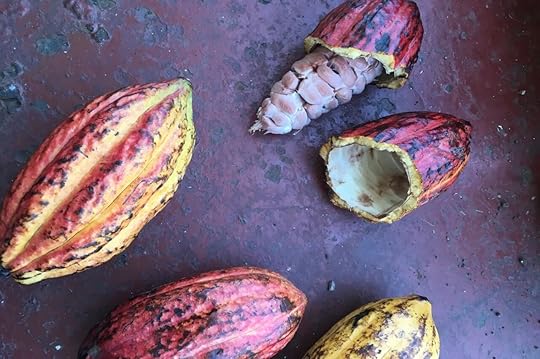
Photo: Airbnb

Photo: Airbnb

Photo: Airbnb
Try out this virtual chocolate making experience and learn about the true history of chocolate. You will learn how to make Jamaican-style chocolate, and will also learn about chocolate origins and how it came to be the world’s favorite sweet treat. You will view how chocolate is made in Jamaica and how it came to be and see the real cacao estate.
Location: Kingston, Jamaica (online experience)
Price: From $15 per person

Photo: Airbnb

Photo: Airbnb

Photo: Airbnb
Enjoy an Airbnb chocolate experience with this Barcelona Chocolate Tour. On this unique sweet excursion, you will learn about the history of chocolate in the beautiful city of Barcelona. You will learn how it made its way from Barcelona to the states, and you will taste your way through the history of chocolate — in Barcelona style.
Location: Barcelona, Spain
Price: From $49 per person

Photo: Airbnb
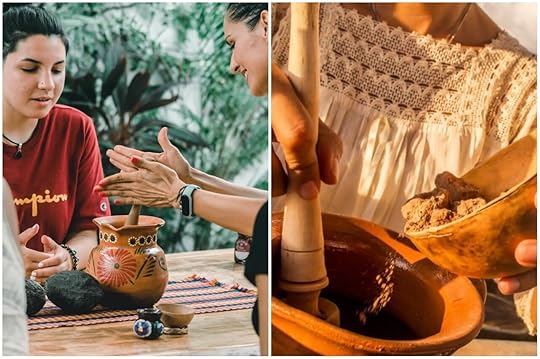
Photo: Airbnb
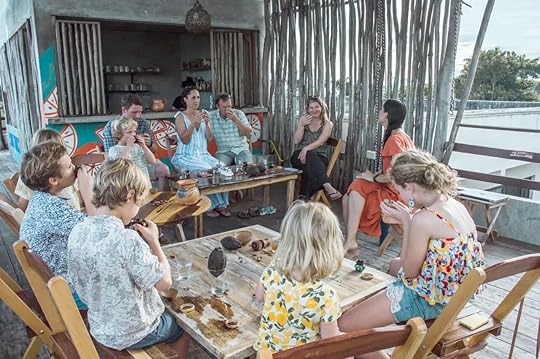
Photo: Airbnb
Here is a Mexican Airbnb chocolate experience that captures the essence of chocolate in the country. The taste properties of cacao were discovered 3,000 years ago, and in this experience, you will learn the cultural background and a variety of flavors and aromas. You will know the Mayas and Aztecs consumed chocolate and conquered Europe. Try handmade chocolate made by Mayan communities in artisanal and sustainable ways. 
Location: Tulum, Mexico
Price: From $57 per person
May 3, 2022
Munich’s Oktoberfest Is Finally Back in 2022 After a Two Year Hiatus

Get ready to eat, drink, and be merry! After a two-year hiatus, Oktoberfest, one of the biggest festivals in Germany, is returning to Munich in late September. Dieter Reiter, the mayor of the Bavarian capital, said the 200-plus-years-old beer-drinking festival would return without restrictions from September 27 to October 3 — just in time for Germany Unity day.
“All Wiesn fans are happy today. I personally am also very happy. The decision gives perspective. For the people and for the economy. I believe that we will experience a mega Wiesn 2022. Because we are already experiencing at the Spring Festival how great people’s desire to celebrate is,” said Munich’s economic officer and head of Oktoberfest Clemens Baumgärtner in a statement.
Like many other grand celebrations around the world. Oktoberfest was canceled due to to pandemic. Rightfully so, considering the festival draws more than six million visitors and takes place under large tents, making social distancing pretty much impossible.
“Ultimately, it’s up to everyone to decide for themselves anyway whether and how much they want to celebrate at the Volksfest,” Reiter said in the statement. “I’m looking forward to a Oktoberfest 2022 that I hope everyone who wants to go will enjoy.”
Although flight prices are going up for spring and summer travel, they typically come back down during the fall, making this a fabulous celebration to travel for if you book in advance. The Wiesn is free to wander through without needing a ticket, but food and drinks are known for being pricey. As of now, Germany welcomes US travelers but requires anyone age 12 and older to be fully vaccinated, according to the German Missions in the United States. Germany also caveats that anyone who received a Johnson & Johnson vaccine must have two shots to be considered fully vaccinated.
If you’re not sure you’ll make it to the motherland of Oktoberfest, there are plenty of amazing versions in the United States. The best festivals confirmed to return in 2022 include Georgia, Oklahoma, Texas, Ohio, Washington, Oregon, and Wisconsin. So if you’re a beer drinker who loves rotisserie chicken, soft pretzels, and great costumes, there’s no reason to miss out on the chance to live it up. 
You Can Rent the Famous Moulin Rouge Windmill for €1 a Night on Airbnb

Take a second to set a reminder for May 17, because from 7:00 PM that evening, you can request to book the Moulin Rouge Airbnb in Paris for just €1 a night. For the first time, the iconic red windmill will open its doors to the public, allowing an overnight stay for two. As well as exclusive access to the Parisian landmark, guests will be whisked backstage before being ushered to the best seats for Féerie, Moulin Rouge’s renowned cabaret.
We hope you love the Moulin Rouge Airbnb we recommend! Just so you know, Matador may collect a small commission from the links on this page if you decide to book a stay.
In the cobblestone streets of Montmartre, one of the most famous Parisian districts, the Moulin Rouge is the birthplace of the French Cancan. Recognizable by its red windmill, the building and cabaret show attracts nearly 600,000 visitors every year. The windmill was constructed in 1889, but this is the first time the general public has been offered the chance to book an overnight stay.

Photo: Airbnb/Daniel Alexander Harris
Airbnb teamed up with renowned 19th-century French historian, Jean-Claude Yon, to renovate the space into its former glory.
“The Belle époque era was a time when French culture and arts flourished — and no landmark is more iconic to that period than the Moulin Rouge,” Yon said in a statement. “This secret room inside the cabaret’s famous windmill has been designed to take you on an authentic journey back in time to experience the French capital of arts and pleasures during a moment in history.”

Photo: Airbnb/Daniel Alexander Harris

Photo: Airbnb/Daniel Alexander Harris

Photo: Airbnb/Daniel Alexander Harris

Photo: Airbnb/Daniel Alexander Harris
From the vintage costumes, to the fragrant perfume on the antique dressing table, to the rich lavish textiles, every little detail in this Airbnb is opulent and authentic.

Airbnb host and lead dancer at the Moulin Rouge, Claudine Van Den Bergh. Photo: Airbnb/Daniel Alexander Harris
The host and lead dancer of Féerie, Claudine Van Den Bergh, will also meet the lucky guests. Before the show, resident chef Arnaud Demerville will prepare a traditional French three-course dinner on the romantic rooftop terrace.
The Moulin Rouge Airbnb will be available for one night stays on June 13, 20, and 27. Booking requests open on May 17 at 7:00 PM and cost €1. If you’re not able to snag a night at the Moulin Rouge, check out Matador’s extensive list of the most luxurious Airbnbs in Paris. 
LGBTQ travel in Salt Lake City

Salt Lake City is queer — and not just in the “Donny Osmond singing and dancing in a rainbow-colored coat” kind of way. It’s queer because it defies simple categorization. Although there are 1.2 million residents, SLC feels like a small town where everybody knows your name. In the height of summer, you can burn in the brown desert hills of downtown only to freeze by piles of snow in the verdant Wasatch Mountains 45 minutes away. Most importantly, Salt Lake City is both a conservative Mormon metropolis and a progressive LGBTQ+ capital. On a single sidewalk, you can pass a stately family heading to Sunday service at the Church of Jesus Christ of Latter-Day Saints (LDS) followed by a tattooed gay couple on their way to brunch.
What makes this queerness exciting is that it’s unexpected. After Mormon leader Brigham Young led his band of religious misfits to Ensign Peak and proclaimed the Salt Lake Valley their promised land in 1847, the Mormon population exploded. For a long time after, the conservative values of Mormonism dominated local culture. In recent years, much of that has changed. The city’s LDS population slipped to 48 percent in 2018, and while the rest of Utah is still overwhelmingly Mormon, the counterculture has finally laid claim to the state’s capital.
Community in gay Salt Lake CityGay bars in Salt Lake CityLGBTQ+ ally establishmentsEvents in Salt Lake CityWhere to stay in Salt Lake CityLGBTQ+ resources in Salt Lake CityCommunity in gay Salt Lake City
Photo: Austen Diamond Photography/Visit Salt Lake
Nowhere is this change more pronounced than in Salt Lake’s flourishing LGBTQ+ community. In 2015, Jackie Biskupski became the city’s first openly gay mayor. She currently serves with three openly gay city council members: Amy Fowler, Derek Kitchen, and Chris Wharton. SLC is so queer-friendly that officials renamed a street in honor of the politician and gay rights activist Harvey Milk in 2016. The same year Biskupski was elected, Gallup released a poll naming Salt Lake City the seventh gayest city in the United States. A whopping 4.7 percent of the population identifies as LGBT. That’s higher than both New York City and Los Angeles.
In some ways, Salt Lake City is so gay it’s post-gay. You’ll find queer folks congregating in neighborhoods like Sugar House, the Marmalade District of Capitol Hill, and in the Avenues near Temple Square, but there’s no true gayborhood of which to speak. It’s easy to see why. The city is chock-a-block with hip coffee shops, international food options, artistic offerings, and enough outdoor activities to make you feel you’re living in a Patagonia clothing ad.
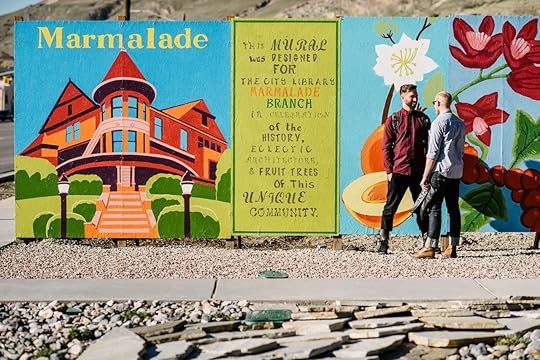
Photo: Austen Diamond Photography/Visit Salt Lake
From the pink water of the Great Salt Lake to the snow-capped peaks of the rainbow-colored mountains, Salt Lake City is to Utah what Austin is to Texas: a liberal island in a sea of conservatism. Only while Austin wants you to “keep it weird,” the slogan Salt Lake City needs to start marketing is “keep it queer.” It’s got the queer part down pat — now it needs LGBTQ+ travelers to come experience it for themselves.
Gay bars in Salt Lake City
Photo: Austen Diamond Photography/Visit Salt Lake
The Moose LoungeThis straight lounge becomes a queer dance club once every week for Revolution Fridays. Expect live DJs, drag queens, go-go dancers, and a weekly party theme inviting you to dress up so you can get down in style. Arrive before 11:00 PM for free entry.
Address: 180 West 400 South
Club Try-AnglesThis laid-back bar is famous for cheap drinks, Thursday night karaoke, and Sunday BBQs on the patio between Mother’s Day and Labor Day. The local crowd gets rowdy on the third Thursday of every month after checking their clothes for the Underwear Party. Leave the long Mormon garments at home, this event is more Andrew Christian than Joseph Smith.
Address: 251 West 900 South
Metro Music HallAlthough this midsize concert venue isn’t explicitly gay, Metro hosts the city’s best drag shows (it’s the number one place to find the girls of RuPaul’s Drag Race when they’re in town). Even when drag is off the menu, the space caters to SLC’s alternative crowd with a range of live events to suit almost everyone’s taste. Check the website to see who’s playing and buy tickets in advance.
Address: 615 West 100 South
LGBTQ+ ally establishments
Photo: Austen Diamond Photography/Visit Salt Lake
Coffee and gays are both ex-nays for Mormons, and you’ll often find both frequently paired together. Coffee Garden, located on Harvey Milk Boulevard, is a long-running LGBTQ+ favorite with a rainbow flag hanging prominently in the window. Publik Coffee Roaster, a hipster java joint with two locations (one in the fashionable Avenues neighborhood and another closer to downtown) is another worthy stop with a small but mighty menu of light bites.
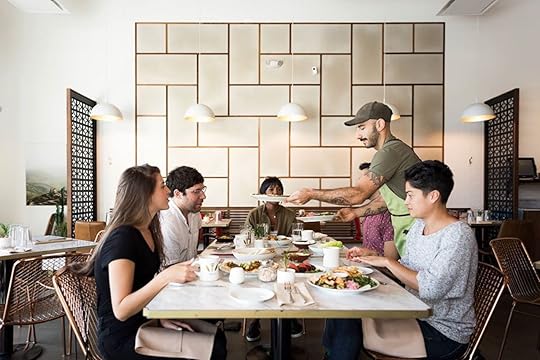
Photo: Laziz Kitchen/Facebook
If you’re feeling ravenous, join the “hummus-sexual” revolution by grabbing a meal at Laziz, a gay-owned Lebanese restaurant. For adult beverages (another Mormon no-no) try Bar-X, a Prohibition-era lounge co-owned by Modern Family star Ty Burrell. Check out Beer Bar next door while you’re there.
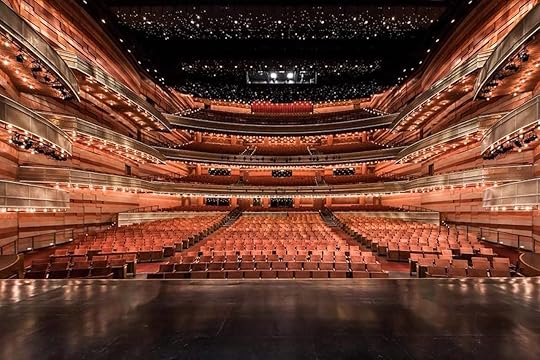
Photo: Broadway at the Eccles/Facebook
If you’re looking for late-night alternatives to loud bars, Salt Lake City is nationally renowned for its vibrant performing arts community. The Eccles Theater, a recently renovated arts complex located just south of Temple Square, hosts Broadway tours and concerts. Pioneer Theatre Company and Salt Lake Acting Company, two acclaimed regional houses, produce new works, pre-Broadway tryouts, and revivals of contemporary musicals and plays year-round.
Events in Salt Lake CityUtah Gay Ski Week
Photo: Elevation Gay Ski Week/Facebook
Park City, a 45-minute drive from downtown SLC, is a Wasatch Mountains town with Swiss Alps vibes that’s worth checking out at all times of the year. But for gay travelers, the area’s famous ski slopes have decidedly more swish during Elevation: Utah’s gay ski week. Between skiing all day and dancing all night, this five-day meet-up in Park City’s winter wonderland is the ultimate gay sleep-away camp. Check the website for dates and participating hotel recommendations.
Address: Park City, Utah
When: February

Photo: Utah Film Center/Facebook
The nearby town of Park City might have Sundance, but downtown Salt Lake City has Damn These Heels — an LGBTQ+ film festival that takes place every summer. In nearly two decades of operation, the weekend-long festival has screened over 220 films focused on telling stories by and about the LGBTQ+ community.
Address: Rose Wagner Performing Arts Center, 138 Broadway
When: October

Photo: LOVELOUD/Facebook
In 2017, Imagine Dragons frontman Dan Reynolds began a family-friendly music festival to raise awareness, understanding, acceptance, and support for LGBTQ+ youth. The event, which takes place every summer in the USANA Amphitheater just outside SLC, has garnered national attention in past years with headliners like Kesha and Tegan & Sara. Proceeds from the festival benefit organizations like The Trevor Project, GLAAD, and the Human Rights Campaign, among others.
Address: 5150 Upper Ridge Road, West Valley City
When: May

Photo: Brent Olson/Shutterstock
When Salt Lake City threw its first Pride parade in 1990, around 250 people attended. Today, the parade regularly attracts upwards of 50,000 participants. The parade, along with a Dyke March and interfaith service, takes place on the first Sunday in June and marches from 200 South West Temple to 400 East. Other events throughout the weekend include a 5K race, youth dance, film festival, and a series of speeches and live performances. The most well-attended event is the Pride Festival, which takes place on both Saturday and Sunday in and around Washington Square.
Address: 200 South West Temple to 400 East
When: June
Matador has an extensive list of the best Airbnbs in Salt Lake City, but below are a handful of well-reviewed, Superhost standard, and central rentals perfect for a weekend away.
We hope you love the spaces and stays we recommend! Just so you know, Matador may collect a small commission from the links on this page if you decide to book a stay.
One-bedroom apartment in Downtown Salt Lake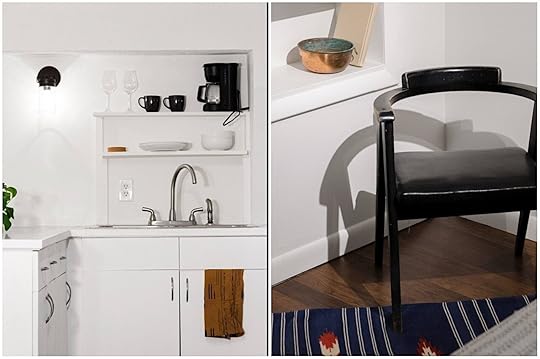
Photo: Airbnb

Photo: Airbnb
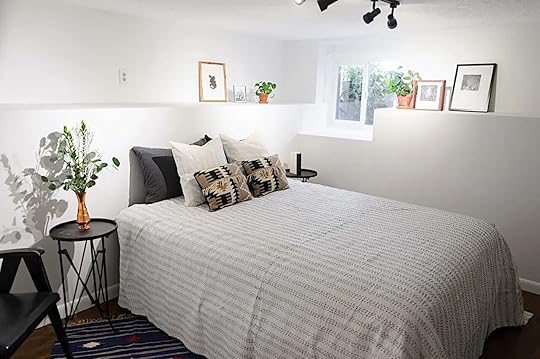
Photo: Airbnb
This is a great spacious suite if you’re hoping to stay Downtown. The private garden-level basement apartment is in a boutique old-French style property. It is simple, but it has everything you’ll need for a comfortable stay. The kitchen is basic but caters to guests who and to whip up breakfast or a light meal.
Comfortable apartment five minutes from Temple Square
Photo: Airbnb

Photo: Airbnb
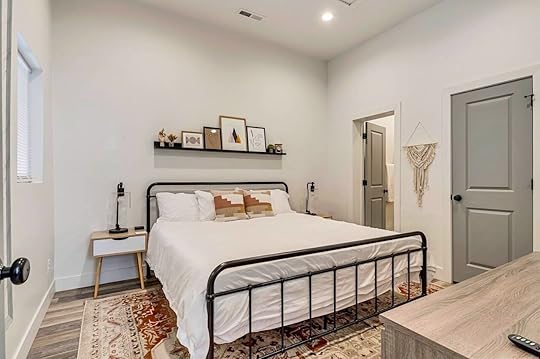
Photo: Airbnb
Another great option for location, this Airbnb, is a short stroll from Temple Square and Downtown, and ten minutes from the airport. Another tremendous bonus is that there is a parking space for one car. The apartment has one bedroom, but there’s a comfortable futon so it can sleep up to five guests.
Newly restored one-bedroom apartment in Salt Lake City
Photo: Airbnb

Photo: Airbnb

Photo: Airbnb
Modern and recently restored the one-bedroom comfortably sleeps four. There’s a pullout couch in the spacious living room and the kitchen is fully equipt for a small group. Filled with plants with a modern, clean design aesthetic, this is a brilliant spot in the city to make a base.
Stylish and centrally located three-bedroom apartment
Photo: Airbnb

Photo: Airbnb

Photo: Airbnb
Six guests are welcome to rent this central Airbnb and if they all want to drive separately, there’s parking for six vehicles. The kitchen is bright; the living room packed with color, and they impeccably designed bedrooms. It’s one of the most stunning rentals we’ve come across on the booking site.
LGBTQ+ resources in Salt Lake City
Photo: Utah Pride Center/Facebook
The Utah Pride CenterThis non-profit community center has been the beating heart of Salt Lake City’s LGBTQ+ scene since 1992. With counseling, support services, and programs like the Utah Queer Historical Society, the Pride Center is a safe space and valuable resource for locals and visitors looking to connect.
Address: 1380 Main Street 
4 New Google Updates Just Made It so Easier To Plan Your Summer Travel

When getting ready to plan your vacation, there are plenty of apps and websites that promise to find the cheapest flights and hotel deals. Google updated a slew of features to make finding the best deals easy, whether you want to travel to a destination on the other side of the world or look for a quick weekend getaway.
New ways to plan travel using GoogleTrack flight prices for any dates: Now Google flight users will be able to do more than get price drop notifications for specific dates. Users can sign up to get notified of low prices for any dates showing significant price drops.Browse destinations within driving distance: Users can use Google’s Explore Tool’s new pink button “Explore nearby” to find destinations to drive to, along with hotel prices in that area and the expected weather conditions.Find the best place to stay: When booking a hotel, users can use Google not only to find a place to stay but to find the best neighborhoods to stay in based on options to shop, dine, and nearby attractions.Keep organized while you plan: To keep up with all the important details of your dream vacation, users can bookmark hotels and vacation rentals to easily pick up where you’ve left off.Google’s new option for tracking flights for any date is an expansion of the options users already had. Let’s say you’re looking for a vacation to a specific destination, but you want to do it during a particular time of year. Google Flights users can use the flexible dates option to find the best time to ask for days off in June for a three-night stay.
If you’re interested in finding the most sustainable ways to travel, Google has other tools to help you feel good about making the right decision for the planet. When searching for hotels on Google, users can see whether a hotel meets high sustainability standards by looking out for the sustainability badge. And when you’re deciding on how you’ll travel to your destination, you can use Google Maps to find the most eco-friendly route for your trip.
With all of Google’s travel tools, planning a fabulous vacation will be less stressful and less costly, putting you in the perfect mindset while you count down the days to your getaway. 
Hilton’s Vallarta Riviera Wants To Change Your Mind About Booking All-Inclusives

Before I stayed at the Hilton Vallarta Riviera, I have to admit, just the idea of staying at an all-inclusive resort made me pretty nervous. When I thought of “all-inclusive”, I pictured bland food and stale pizza, watered-down drinks, and a rowdy environment of drunk party-goers because, well, it’s all-inclusive. It’s just not my style. When I go on vacation, I want to have a luxurious experience away from the hustle and bustle of everyday life. I’m willing to pay for my own food, drinks, and excursions, even if it costs a bit extra.
I also want to ensure I have an authentic experience, not just an Americanized version of the destination. It can be hard to find that balance. A few weeks before staying at the Hilton Vallarta Riviera, I was in Cancun. I stayed at a resort with an all-inclusive option that I did not pay for, but we decided to eat at the resort a couple of times. The food was definitely below my standards, and one meal was so awful we left the restaurant after only having a few bites of food. The few times we ordered room service because we were too lazy to go out, I found the food bland in a country known for its bright, bold flavors. The Hilton Vallarta is doing things a bit differently, using the town’s natural beauty and culture, which makes for a unique stay.
“I think we have this idea of an all-inclusive being, we’re just hanging out by the pool, have four hamburgers and two hotdogs, and bring all the margaritas and all the Pina Coladas. Hilton has just entered into the all-inclusive area, and we want to do things differently. And I think the best way of doing that is bringing the local culture into the guest experience,” said Monica Gonzalez, director of sales and marketing. “… not only for the food and beverage but also in the entertainment product. And having something that’s special for every single member of the family.
The property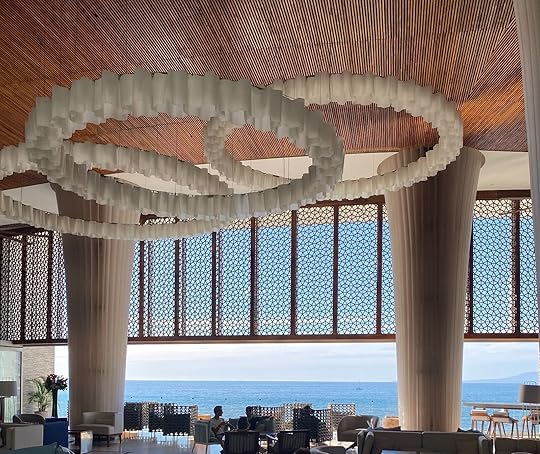
Photo: Olivia Harden
The hotel is about a 45-minute taxi ride from the Licenciado Gustavo Díaz Ordaz International Airport. You can also set up a ride through the hotel prior to arrival. I walked into one of the most gorgeous lobbies I’ve ever seen. Many of the hotel common areas are open-air bringing the beauty of Puerto directly to you, which is why the first thing you get is an incredible ocean view met with the sounds of the waves. I headed to check-in, where I received a traditional cocktail upon arrival, a card that was good for one beach towel, a wristband with a wooden charm that doubled as my room key, and a way to signal to hotel staff that I had all-inclusive access. Most all-inclusive hotels tend to be adults only. However, since Hilton began managing the property, it is now family-friendly, which could be helpful if you’re a family on a budget. Still, it did make me nervous about kids running around everywhere. However, my room was located in an adults-only tower, which I think is a smart way to let both solo adults and families enjoy the experience.
“So what we’re trying to do is, for example, if we have night entertainment, we will have something for kids, something for teens, and we will have something for parents. So our rally cry is to experience the joy of connection. What we’re trying to pursue is that when the kid, the teen, and the parents just come together, they start to talk about what they just experienced, and we are creating memories,” Gonzalez said.
I headed to the adults-only tower, noticing that the tower had the same feel as the lobby. Instead of traditional windows, natural-looking openings offer views of the ocean and poolside area, letting you enjoy a sea breeze. I headed up the elevator and arrived at my room. The room was an oceanfront room with a king-size bed. At the Hilton Vallarta, every single room in the hotel has an ocean view, which means no one misses out on something so special about the property.
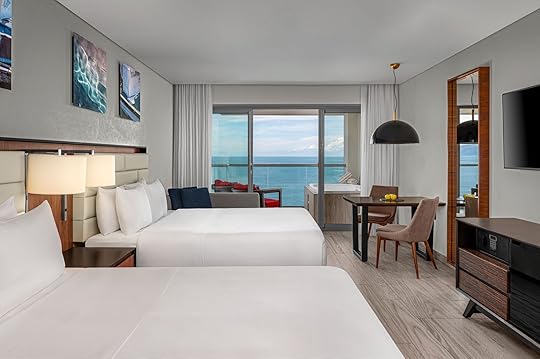
Photo: Hilton Vallarta Riviera
The room was beautiful and tranquil. The marble bathroom has a rainfall shower, and the bedroom hosts a king-size bed with crisp linens, a grey lounger, a flat-screen tv, and a dining room table set. But the balcony with the ocean view and two lounge chairs is the obvious focal point. But if I’m being honest, the room isn’t what makes the property special. Don’t get me wrong, it’s beautiful and a great landing point during the day, but there are plenty of beautiful hotel rooms all across Mexico. Puerto Vallarta has a different history than other popular spots in Mexico, like Cancun and Cabo.
“Don’t get me wrong, I actually love going to Cancun, however, I think everything gets built for tourism. So it was a land that started 40 years ago, and everything was created from scratch for tourists. Cabo, it was pretty much the same thing — being so close to the United States, it became a really popular destination for Americans to come and visit,” Gonzalez said. “Puerto Vallarta was a fisherman village that was founded 100 years ago, and tourism started to grow around this. So it actually kept the spirit in the tradition of that village, which was amazing. It turns out that Elizabeth Taylor came here once she fell in love with the destination … so that’s why everyone turned their heads to come over here, and again, tourism started to grow from that. Everything you taste, everywhere you walk, it’s Mexico.”
While I enjoyed the property, I spent some time at the pool and beach. This family-friendly resort has an adults-only pool, but it’s pretty close to the family pool, so don’t expect an abundance of quiet. I also spent time in a reserved private cabana with a super comfortable daybed, but there were few cabanas that actually offered a view of the beach or any sun, which was a bummer. However, the hotel does offer great beach access. You can’t go too far out, but I enjoyed a leisurely walk and some time in the water.
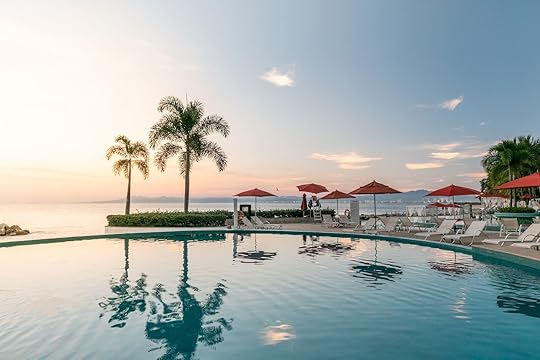
Photo: Hilton Vallarta Riviera
If you’re looking for a relaxing experience, I would definitely recommend the eforea Spa. I decided to get a mud wrap — an 80-minute luxurious treatment that included a full-body exfoliation followed by mud that softened the skin. When it was over, I found myself so relaxed that I could’ve stayed there forever. Booking a treatment also grants you access to the spa’s amenities like the hydrotherapy pools, a steam room, sauna, and whirlpools.
What to eat
Photo: Olivia Harden
Hilton’s approach to the all-inclusive resort in Puerto Vallarta means you can enjoy the cultural significance of Puerto Vallarta without ever leaving the resort. Remember how I said I was nervous about trying food on the property? I’m happy to report that almost everything I ate or drank was really tasty! My biggest tip? Skip any buffets. In the age of COVID-19, I still find buffets to be a less sanitary option, and the food subpar. Why go to a breakfast buffet downstairs when you can have freshly made chilaquiles delivered to your room for a lazy morning? Feel free to eat on your balcony and take in the waves, or enjoy breakfast in bed. You definitely don’t want to miss the Mojito Lounge located on the fifth floor. The specialty is mojitos in several different flavors (although I had a regular one because I’m pretty boring) and they were paired with yummy appetizers.
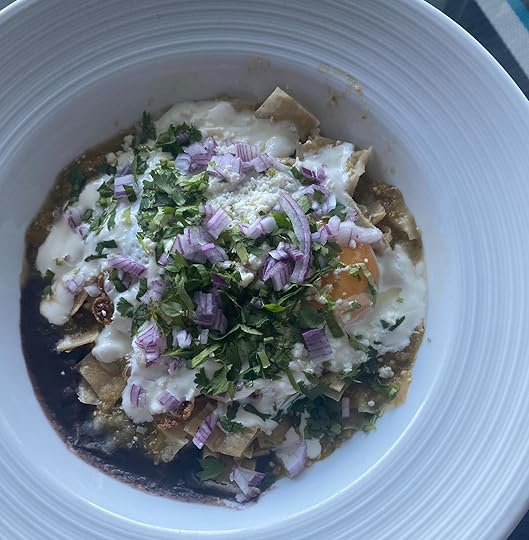
Photo: Olivia Harden
My favorite place to eat was Cocomar. The restaurant was highly recommended by the hotel staff for the several types of ceviche they had on the menu, and all three I tried was delicious. My favorite was the traditional Vallarta ceviche made of ground white fish, lemon, carrot, a Mexican sauce, and mayonnaise served with crackers and chips. I honestly could’ve eaten the whole bowl by myself. Another great restaurant is La Luce, which serves Italian cuisine. I enjoyed the Ai Funghi, a mushroom risotto. And of course, you can’t come to Mexico without eating chips and fresh guacamole which I ordered poolside.
What to do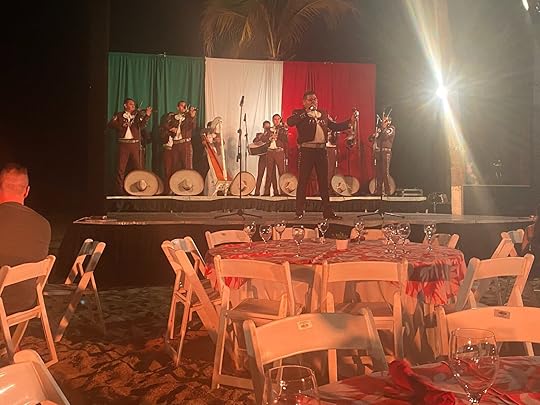
Photo: Olivia Harden
The Hilton Vallarta is jam-packed with activities including ping-pong tournaments, water fitness, Latin dance lessons, beach volleyball, and more. I took a morning sun salutation yoga session at the Sky Bar which is located on a rooftop deck with a gorgeous view of the ocean. The session was not a typical, Americanized yoga session. Instead, the experience included shaman rituals including a smoke cleanse, rhythmic drums, and knowledge of Indigenous people’s interaction with nature. This is a perfect way to start your day. Another activity I loved was the tequila tasting. I’ve done tequila tastings before, but never like this. Each tequila was paired with proper accompaniments, and I learned the history of tequila in Puerto Vallarta and across Mexico.
I also recommend the Mexican Show held poolside. There is a buffet, which I would suggest you eat beforehand, but the performances are really special. There was an amazing Mariachi band and later, a dance performance where the dancers showcased each of the 32 states of Mexico. For each state the dancers changed into different costumes and showcased traditional dances that highlighted the diversity of Mexico. Following the show was a silent disco located at the Sky Bar where I was fitted out with a pair of headphones for a dance party with music on two different stations. It was so fun to let loose!
When it’s time to head home the hotel makes it really easy to schedule a COVID-19 test so you can return home. However, I opted to bring my own. eMed’s BinaxNOW COVID-19 Ag Card Home Test is easy to use and travel approved, as it is still the only at-home test approved for returning international flights.
Overall, I would definitely return to the Hilton Vallarta Riviera. While I always recommend traveling off property to immerse yourself in a destination, this hotel is a great all-inclusive resort in Puerto Vallarta with tasty options and great entertainment that is in tune with Puerto Vallarta’s culture and won’t break the bank.
Matador Network's Blog
- Matador Network's profile
- 6 followers



